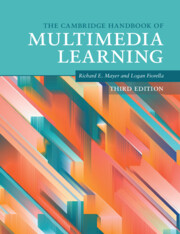Book contents
- The Cambridge Handbook of Multimedia Learning
- The Cambridge Handbook of Multimedia Learning
- Copyright page
- Contents
- Figures
- Tables
- Contributors
- Preface
- Acknowledgments
- Part I Background
- Part II Theoretical Foundations
- Part III Basic Principles of Multimedia Learning
- Part IV Principles for Reducing Extraneous Processing in Multimedia Learning
- Part V Principles for Managing Essential Processing in Multimedia Learning
- 19 Principles for Managing Essential Processing in Multimedia Learning
- 20 The Modality Principle in Multimedia Learning
- 21 The Transient Information Principle in Multimedia Learning
- Part VI Principles Based on Social and Affective Features of Multimedia Learning
- Part VII Principles Based on Generative Activity in Multimedia Learning
- Part VIII Multimedia Learning with Media
- Author Index
- Subject Index
- References
20 - The Modality Principle in Multimedia Learning
from Part V - Principles for Managing Essential Processing in Multimedia Learning
Published online by Cambridge University Press: 19 November 2021
- The Cambridge Handbook of Multimedia Learning
- The Cambridge Handbook of Multimedia Learning
- Copyright page
- Contents
- Figures
- Tables
- Contributors
- Preface
- Acknowledgments
- Part I Background
- Part II Theoretical Foundations
- Part III Basic Principles of Multimedia Learning
- Part IV Principles for Reducing Extraneous Processing in Multimedia Learning
- Part V Principles for Managing Essential Processing in Multimedia Learning
- 19 Principles for Managing Essential Processing in Multimedia Learning
- 20 The Modality Principle in Multimedia Learning
- 21 The Transient Information Principle in Multimedia Learning
- Part VI Principles Based on Social and Affective Features of Multimedia Learning
- Part VII Principles Based on Generative Activity in Multimedia Learning
- Part VIII Multimedia Learning with Media
- Author Index
- Subject Index
- References
Summary
When dealing with instructional information, working memory can be divided into auditory and visual processors. The capacity limits of each processor are a major impediment when students are required to learn new material. Nevertheless, there is one strategy that can effectively expand working memory capacity by using the partially independent status of the auditory and visual processors. Under specific and well-defined conditions, presenting some information in visual mode and other information in auditory mode can increase effective working memory capacity and so reduce the effects of cognitive overload. This effect is called the instructional modality effect or modality principle. It is an instructional principle that can substantially increase learning. This chapter discusses the theory and data that underpin the principle and the instructional implications that flow from the principle.
Keywords
- Type
- Chapter
- Information
- The Cambridge Handbook of Multimedia Learning , pp. 261 - 267Publisher: Cambridge University PressPrint publication year: 2021
References
- 14
- Cited by

